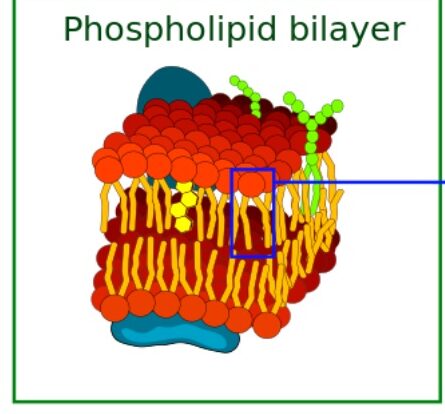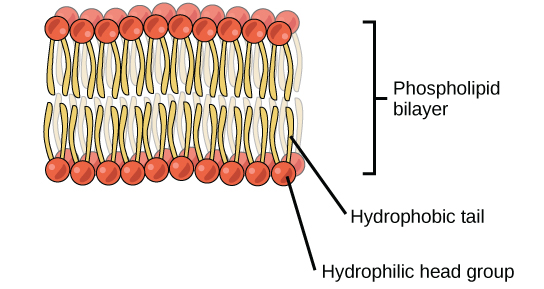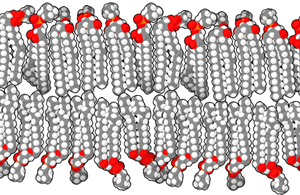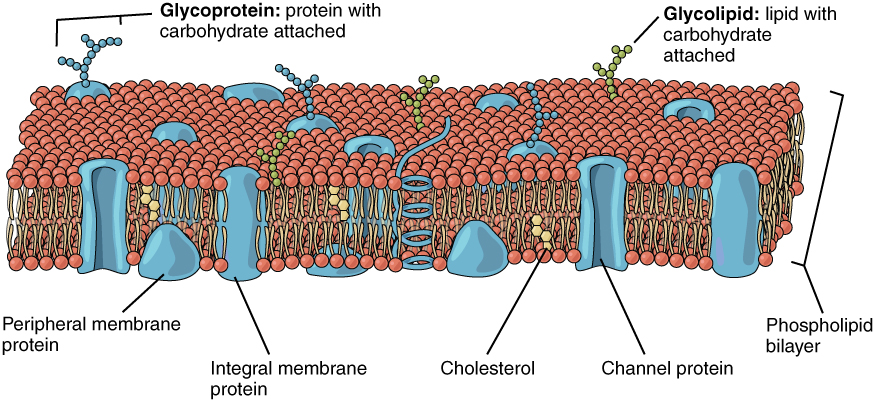Chapter 9: Cell Membrane and Transport Mechanisms
9.1. Structure and Composition of the Cell Membrane
Learning Objectives
By the end of this section, you will be able to:
- Describe the molecular components that make up the cell membrane.
- Explain the major features and properties of the cell membrane and what makes the membrane selectively permeable.
- Describe the fluid mosaic model of the cell membrane.
- Differentiate between materials that can and cannot diffuse through the lipid bilayer.

The plasma membrane contains phospholipids, cholesterol and proteins. Its major component are phospholipids arranged in two layers (a phospholipid bilayer) (Figure 9.1.1.). Cholesterol is inserted in the membrane affects membrane consistency. Proteins embedded within the membrane play various roles in maintaining the life of the cell.
Recall that phospholipid molecules are amphipathic (refer Section 7.2) and this characteristic of the head and tail are responsible for the formation of the bilayer which spontaneously forms in polar water (called ‘self-assembly’). The hydrophobic tails orient away from water and face either other. The polar heads face water that is inside and outside the cell (Figure 9.1.2.)

Factors affecting membrane ‘fluidity’ and the Fluid Mosaic Model
The ratio of saturated to unsaturated fatty acids in phospholipids affects the membranes consistency or “fluidity”. Recall that lipids containing mostly saturated fatty acids (e.g., butter) are solid and those composed of unsaturated fatty acids (oils) are liquid. A mix fatty acid classes in the membrane results in a “vegetable oil” consistency. The phospholipid chemistry gives a membrane fluidity with bilayer molecules constantly in a lateral flow of motion (Figure 4), To modulate the degree of membrane fluidity cholesterol, a largely hydrophobic molecule, is inserted in the membrane (shown in yellow in Figure 9.1.4.)

Cell membrane structure is described in a fluid mosaic model. The model describes the selectively permeable semi-fluid plasma membrane formed by phospholipids, cholesterol and membrane proteins (Figure 9.1.4.). The ‘fluid’ description relates to the phospholipids moving freely amongst each other and the mosaics descriptions membrane proteins distributed throughout the membrane. Membrane proteins may be located at the membrane surfaces (peripheral proteins) of the membrane or extend through the bilayer (integral proteins).

License and attributions:
- Concepts of Biology, 2013, Fowler, S. et al. License: CC BY 4.0. Located at https://openstax.org/books/concepts-biology/pages/3-6-active-transport
- Anatomy and Physiology, Second edition, 2022, Betts, J.G. et al. License: CC BY 4.0. Located at https://openstax.org/books/anatomy-and-physiology-2e/pages/3-1-the-cell-membrane
- Supplement for General Biology – OpenStax Biology, (n.d.) Seto, J. License: CC BY-NC-SA 3.0. Located at openlab.citytech.cuny.edu/openstax-bio/exam-2/membranes-transport/
- Wikipedia contributors, 2007, Bensaccount. Licence: PD. Located at https://en.wikipedia.org/wiki/Image:Lipid_bilayer_section.gif
